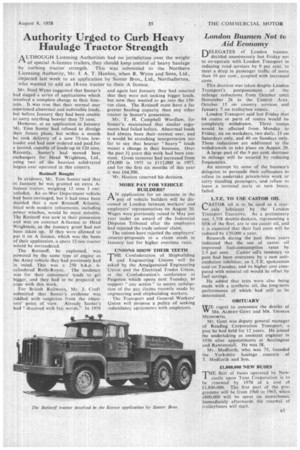Authority Urged to Curb Heavy Haulage Tractor Strength
Page 37

If you've noticed an error in this article please click here to report it so we can fix it.
ALTHOALTHOUGH Licensing Authorities had no jurisdiction over the weight UGH special A-licence trailers, they should keep control of heavy haulage .by curbing tractor strength. This was submitted to the Northern Licensing Authority, Mr. J. A. T. Hanlon, when R. Wynn and Sons, Ltd., 'objected last week to an application by Sunter Bros., Ltd., Northallerton, who wanted to add an 18-ton tractor to their A licence.
Mr. Noel Wynn suggested that Sunter's had staged a series of applications which involved a complete change in their business. It was true that their normal user mentioned abnormal and indivisible loads, but before January they had been unable to carry anything heavier than 75 tons.
However, at an application in January Mr. Tom Sunter had refused to divulge their future: plans, but within a month he took delivery of a new 75-ton lowloader and had now ordered and paid for a second, capable of loads up to 120 tons. Recently, Sunter's had moved heat exchangers for Head Wrightson, Ltd., using two of the heaviest solid-tyred bogies ever operated in this country.
Rotinoff Bought In evidence, Mr. Tom Sunter said that in January he was granted an extra Alicence tractor, weighing 12 tons 3 cwt. unladen. An ex-War Department vehicle had been envisaged, but it had since been decided that a nevi Rotinoff Atlantic, fitted with modern refinements, including power winches, would be more suitable. The Rotinoff was now in their possession and was on contract A-licence to Head Wrightson, so the January grant had not been taken up. If they were allowed to put it on A licence, which was the basis of their application, a spare 12-ton tractor would be surrendered.
The Rotinoff, he explained, was powered by the same type of engine as the Army vehicle they had previously had in mind. This was a 250 b,h.p. 6cylindered Rolls-Royce. The tendency was for their customers' loads "to get bigger, and they had to be prepared to cope with this work.
For British Railways, Mr. J. Croft submitted that Sunter's evidence was riddled with suspicion from the objectors' point of view. Already Sunter's . had deceived with fair words." In 1956
and again last January they had asserted that they were not seeking bigger. loads. but now they wanted to go into the 150ton class. The Rotinott must have a far greater hauling capacity than any other tractor in Sunter's possession.
Mr. T. H. Campbell Wardlaw, for Sunter's. maintained that similar arguments bad failed before. Abnormal loads had always been their normal user, and it would be stretching interpretation too far to say that heavier "heavy" loads meant a change in their business. Over the past 31 years this work had been constant. Gross turnover had increased from £74,000 in 1955 to £112,000 in 1957, and for the first six months of this year it was £64,500.
Mr. 'Hanlon reserved his decision.




































































































